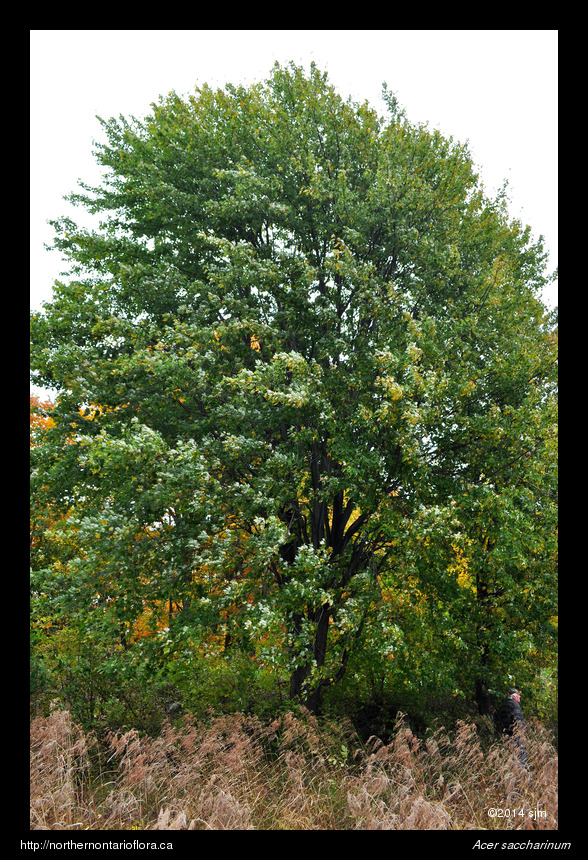
|
Northern Ontario Plant Database 
Plant DescriptionAcer saccharinum L.En: silver maple, river maple, white maple
Sapindaceae (Soapberry Family) The Genus Acer: Maples are tall shrubs or trees with opposite, deciduous leaves. Most maples have simple, palmately-lobed leaves, with the exception of Acer negundo (Manitoba maple or box elder), which has pinnnately compound leaves. Most have buds with overlapping (imbricate) bud scales and narrow V- or U-shaped leaf scars with 3 bundle scars. The small bisexual or unisexual flowers have 5 sepals, 5 petals, 10 stamens and/or a 2-carpelled ovary surrounded at the base by a nectar-producing disk; the ovary develops into a pair of indehiscent, winged samaras, commonly called maple "keys", which are wind-dispersed. Some maple species are bisexual, others have both male and female parts in the same flower, but in these, only one sex is functional. General: a tree, to 30 m tall, with slender, often pendulous branches. Bark grayish, furrowed; young twigs chestnut-brown to red, glabrous, with an unpleasant odour when crushed. Buds are dark red with 4 bud scales, similar in appearance to those of red maple. Leaves: opposite, simple, palmately-veined, petiolate. Leaf blade deeply cut into 5 palmate lobes, sinuses are deep and acute; the lobes narrow, with acuminate apices, margins coarsely toothed. Leaves are 6–10 cm long; green above, silvery-white beneath, glabrous. Flowers: greenish-yellow to red, arranged in dense clusters, openning before the leaves. Petals lacking, ovary and base of fruit pubescent. Fruit: a pair of winged samaras, 4–8 cm long, reddish-tinged, with an acute angle between the divergent wings. Habitat and Range: Riverbanks, floodplains, lake edges, usually in well-drained alluvial soil, but often planted in cities. Silver maple is a temperate, eastern North American species, restricted in northern Ontario to regions of deciduous forest. Internet Images: The Acer saccharinum webpage, from the Trees of Wisconsin website. Click on the smaller images to view larger, more detailed photos. The Acer saccharinum webpage from the Virginia Tech Dendrology website. The Acer saccharinum webpage from the USDA Silvics of North America website. Similar Species: Acer saccharum (sugar maple) is another native 5-lobed maple, but the leaves are much less divided and less toothed along the margin than the leaves of silver maple. Acer rubrum (red maple) has red-scaled buds similar to those of silver maple, but its leaves are less deeply lobed and not likely to be confused with silver maple. See also the borealforest.org webpages on Acer saccharum (sugar maple), Acer rubrum (red maple), and the introduced Acer platanoides (Norway maple). Back to species list |
||||||||||||||||||||||























